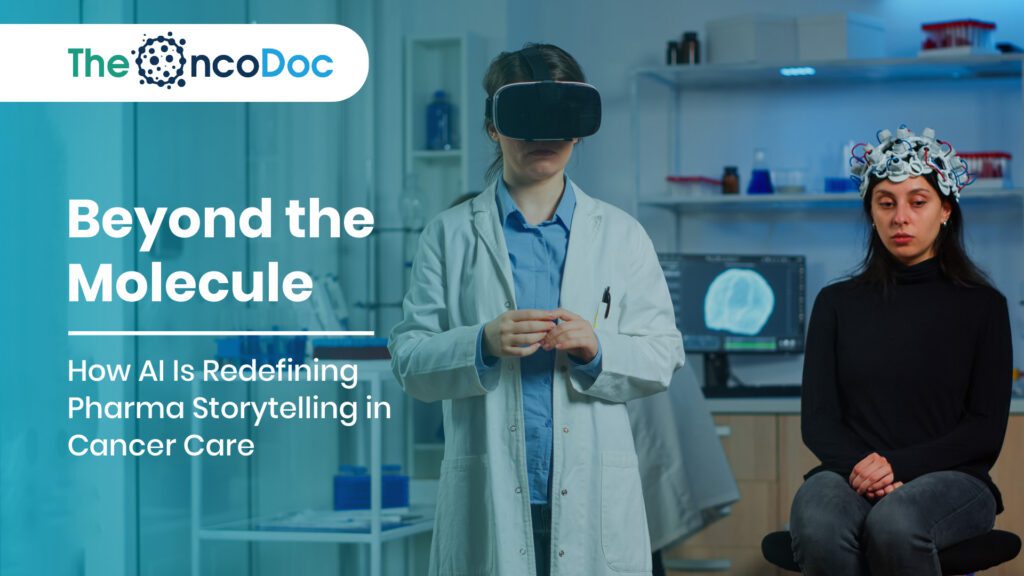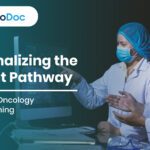Introduction: From Promotion to Precision
In 2025, the oncology pharmaceutical landscape is experiencing a profound transformation, not only in the molecules it develops but in the messages it delivers. For decades, pharma marketing was centered around product attributes, clinical endpoints, and top-down messaging. While effective to a degree, these traditional approaches are increasingly misaligned with the needs of today’s data-savvy, time-constrained oncology professionals.
The shift toward precision medicine has created a new demand for precision storytelling. Oncologists no longer respond to generic promotional tactics; they seek content that mirrors the complexity of cancer care, content that is scientifically robust, clinically relevant, emotionally intelligent, and tailored to the moment of need. And patients, increasingly informed and involved in their own journeys, expect empathy, transparency, and relevance in every interaction with pharma.
This is where artificial intelligence is making a defining impact.
AI is not just transforming how drugs are discovered and trials are designed; it is revolutionizing how stories are told. By turning vast, fragmented data into dynamic, human-centered narratives, AI enables pharma to move beyond the molecule and into the realm of meaningful engagement. AI-powered storytelling doesn’t just inform; it listens, adapts, and responds.
From personalized HCP content journeys and real-time sentiment analysis to predictive patient scenarios and multilingual caregiver tools, AI is empowering pharma to communicate with relevance, resonance, and respect.
This article explores how artificial intelligence is reshaping the very nature of oncology pharma storytelling. Through ten critical shifts and three data-backed visual insights, we unpack how marketing is evolving from promotion to partnership, and why, in cancer care, a well-told, well-timed story can be just as impactful as a breakthrough therapy.
1. The Death of the Monologue: AI Enables Dialogue-Driven Storytelling
Traditional pharma marketing relied on monologue, brands speaking to oncologists and patients. But in oncology, where treatment paths are highly individualized, this approach no longer resonates. AI enables storytelling that listens before it speaks.
By analyzing EMR data, digital footprints, and diagnostic behavior, AI systems can understand what an oncologist is currently researching or which guideline updates they’ve viewed. This allows pharma brands to serve highly contextual stories, like mechanism of action (MOA) animations, clinical trial highlights, or KOL podcasts, based on actual clinical curiosity.
AI transforms storytelling from a pitch into a dialogue, where content is shaped by real-time intent and need. Oncologists become co-narrators in the brand journey.
For years, oncology marketing has been rooted in a one-size-fits-all approach: a static brochure, a keynote presentation, a slide deck circulated through reps. While the intent was educational, the execution often fell flat, delivering content to oncologists rather than building conversations with them.
AI is changing that by making storytelling responsive, conversational, and contextual.
Modern AI systems embedded in CRM platforms, web portals, and mobile apps now track how oncologists engage with content, what videos they finish, which MOA diagrams they pause on, what abstracts they download, and what questions they type into search. These behavioral signals are then used to shape the next piece of content, much like streaming platforms recommend what to watch next.
For example, if an oncologist in a Tier 2 city interacts with an animation on HER2-low breast cancer, the next touchpoint might be a regional case study with local patient outcomes and a quick link to a CME event on HER2 diagnostics. AI doesn’t just deliver; it learns and evolves the story in real time.
This “feedback-informed” storytelling creates a loop of digital empathy, where the brand appears to understand the clinician’s interests and clinical dilemmas. The result is not only higher engagement rates but also deeper trust and clinical relevance.
In essence, AI has turned brand communication into a two-way clinical dialogue, where oncologists are no longer passive recipients; they are active participants in shaping their information journey.
It’s no longer about telling your story. It’s about helping oncologists discover theirs, with your brand as a trusted companion.
2. Personalization at Scale: Crafting Individual Clinical Journeys
One of AI’s most profound contributions to pharma storytelling is the ability to personalize at scale.
By clustering oncologists based on their subspecialty (e.g., breast, lung, GI), location, language, prescribing patterns, and digital behavior, AI creates micro-segments. Each segment receives tailored content journeys, complete with relevant clinical cases, patient vignettes, and trial data.
3. The Emotional Layer: AI Detects Sentiment and Shapes Tone
Storytelling in oncology must balance scientific rigor with emotional sensitivity. AI tools like natural language processing (NLP) and sentiment analysis scan HCP feedback, social media, and patient forums to detect emotional tone.
Is the audience anxious about new side effects? Curious about emerging therapies? Frustrated with access issues?
AI detects these shifts and adjusts the narrative tone, using softer language, offering patient-centered data, or prioritizing reassuring visuals. For example, an email campaign about immunotherapy risks might soften its tone after AI detects caregiver anxiety across support forums.
This layer of emotional intelligence makes AI storytelling feel human, not robotic.
4. The Multichannel Story Arc: Consistency Across Touchpoints
Oncologists don’t engage on a single platform. A single clinical journey might span WhatsApp updates, email summaries, CME webinars, rep visits, and scientific portals. AI ensures that the brand story remains consistent across every touchpoint.
The narrative flow is seamless; each interaction builds on the last. If an oncologist clicked on an EGFR mutation webinar invite, the follow-up email shows trial outcomes in EGFR-positive patients. If they attended the CME, the rep visit reinforces those outcomes with localized real-world data.
This cohesive storytelling enhances memory retention, brand trust, and clinical impact.
5. Interactive Narratives: From Static to Smart Content
AI transforms static stories into interactive experiences.
MOA videos now include quizzes that adjust based on clinician answers. Infographics become clickable dashboards showing regional trial data. Even brochures evolve, featuring QR codes that link to real-time updates or voice-based explanations in local languages.
AI is enabling this shift by turning passive content into dynamic decision tools. Instead of reading about a treatment protocol, oncologists can now interact with case-based simulations, toggle between treatment pathways, or view how a drug performs across biomarker subgroups, all within a single interface.
For instance, consider a lung cancer MOA video that includes embedded decision trees. As the viewer selects a mutation type (e.g., EGFR, ALK, ROS1), the animation adapts in real time to show targeted treatment sequences, survival data, and region-specific guidelines. This “choose-your-own-path” storytelling brings a level of personalization and clinical utility that static formats simply cannot deliver.
AI also powers adaptive landing pages, which restructure themselves based on the user’s specialty, behavior, and previous interactions. A surgical oncologist may see trial outcomes and perioperative data, while a radiation oncologist on the same site receives content on radiosensitization strategies with the same therapy.
Chatbots embedded into content hubs now act as navigators; guiding users to the most relevant information, answering dosing questions, or even generating personalized treatment summaries based on user queries.
This shift is not about flashy design, it’s about functionality. Smart content saves time, improves recall, and provides value in the context of clinical decision-making.
In a field as complex as oncology, where each choice can alter a patient’s course, interactive narratives become more than just marketing tools, they become trusted companions in the care journey.
6. Patient Stories Reimagined: Predictive and Inclusive
Patients are central to oncology storytelling. AI enables patient stories to be not only emotionally compelling but also clinically tailored.
Predictive analytics can simulate patient pathways based on demographics and biomarkers, helping clinicians see projected outcomes visually. For example, a case study might show how a 58-year-old South Asian male with KRAS-mutant colorectal cancer responds to first- and second-line therapies, backed by real-world data.
AI also ensures inclusivity. It helps marketers build patient narratives across ethnicities, languages, socioeconomic contexts, and care settings. Stories become more relatable, and more ethically grounded.
7. Budgeting the Story: Where Pharma Spends on AI-Led Storytelling
AI storytelling doesn’t come free. But where are brands investing most?
8. Evidence-Based Storytelling: Data as the Hero
Every good story needs a protagonist. In oncology marketing, that hero is data.
AI tools allow marketers to embed real-world evidence, population health statistics, and adaptive trial results directly into their narratives. This transforms brand storytelling into something clinicians cite, not just see.
Some of the most trusted campaigns in 2025 include:
- Dashboard-based tumor type updates
- Infographics with RWE comparisons by geography
- Case simulations with real-world treatment outcomes
When stories are backed by credible, granular data, they don’t just inform, they influence.
9. The Future: Storytelling as Clinical Decision Support
We’re entering a future where storytelling doesn’t end with engagement; it drives action.
AI-enabled storytelling tools are becoming embedded within clinical decision support systems (CDSS). Imagine an oncologist entering patient details into an EMR and receiving not just treatment suggestions but tailored brand narratives supported by outcome data, guideline alignment, and patient preference modeling.
At this intersection of narrative and intelligence, marketing becomes medicine’s ally, not just its messenger.
Conclusion: The Era of Intelligent Storytelling
As we move “beyond the molecule,” pharma’s responsibility in oncology is evolving. It’s no longer about broadcasting features, it’s about embedding stories into the rhythm of care.
AI makes this possible. It listens, personalizes, anticipates, and responds. It brings empathy to automation and insight to interaction.
In this new paradigm, every story told is a step toward more informed, compassionate, and effective cancer care.
Because in oncology, stories don’t just sell, they serve.
The Oncodoc team is a group of passionate healthcare and marketing professionals dedicated to delivering accurate, engaging, and impactful content. With expertise across medical research, digital strategy, and clinical communication, the team focuses on empowering healthcare professionals and patients alike. Through evidence-based insights and innovative storytelling, Hidoc aims to bridge the gap between medicine and digital engagement, promoting wellness and informed decision-making.



